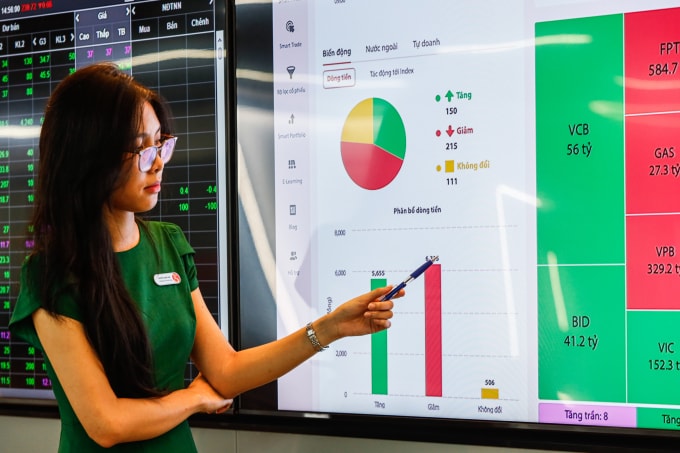When gold prices are at their peak, experts advise people to consider saving money and investing in bonds and stocks - channels with good performance.

At the close of trading on March 28, the price of SJC gold bars was VND100.7 million/tael. The domestic gold price increased in the context of the precious metal on the international market setting a new peak of USD3,077/ounce. The reason is believed to be that investors sought shelter when global trade tensions escalated and stocks fell.
Currently, people who want to buy gold bars must go to SJC stores and state-owned banks, and they must also order online. The situation of unstable transactions still exists, but only locally and at different times. However, many people prefer to buy and sell through the "black market", which has many potential risks.
When forecasting the price of gold this year, Mr. Huynh Trung Khanh, Vice President of the Vietnam Gold Trading Association (VGTA), advised those who do not own gold to allocate 10% of their portfolio to this channel. As for those who already own gold, he advised them to consider buying again at high prices.
According to Ms. Lai Thi Thanh Nga, financial advisor of FIDT, the high gold price is also the time when investors can look to new investment directions. Because if the world situation is stable or there is government intervention, the price may decrease. This consulting and asset management unit of more than 15,700 billion VND suggests that if investors do not buy gold, they can refer to channels such as bank deposits, corporate bonds, and stocks.
Bank deposits are a good choice for investors with low risk appetite. In 2025, interest rates on bank deposits will increase slightly thanks to the State Bank's adjustment policy, but will still be around 5-6% per year. Compared to other channels, this figure is not too outstanding. However, the plus point is that depositors do not have to worry about risks, money is always kept safe.
Experts recommend depositing a maximum of about 20 - 30% of assets with a term of 6 months or 1 year to have a flexible reserve that can be easily withdrawn when needed.
In parallel, corporate bonds are also a channel with attractive interest rates. In the context of yields that are superior to savings interest rates, usually around 7-10% per year, investors with a balanced and growth risk appetite are recommended to consider allocating 5-10% of their asset portfolio to safe corporate bonds. This is an opportunity to take advantage of attractive yields and improve investment efficiency.
If you choose to participate yourself, investors should buy individual bonds from large, reputable companies. In addition, investing through bond fund certificates is also a good choice because there are experts to manage them for us.
The next asset channel worth considering is stocks, which are considered an opportunity for the patient. According to statistics from reporters since the beginning of the year, most analysis groups predict that the VN-Index will close the year at a minimum of over 1,300 points, and at a maximum of close to 1,500 points. The basis for the scenarios comes from the forecast of positive corporate profit growth, faster economic growth, and continued easing of fiscal policy. Some units also rely on the expected rapid disbursement of public investment and the possibility of an upcoming market upgrade.
According to FIDT's calculations, if chosen correctly, investors can achieve a profit of 10 - 15% per year, or even higher. Experts suggest spending 50 - 60% of assets on stocks if you are willing to wait for results after a few years.
In addition to direct purchases, a safe choice for beginners is open-end stock funds or ETFs - where you hand over your money to a professional manager, without having to monitor it yourself too much. However, when the economy shows signs of slowing down, you should reduce this ratio to protect the money you have earned.

For those who want to spend all their idle money on stocks, Mr. Nguyen Dai Hiep, Director of Personal Customer Consulting of Rong Viet Securities (VDSC), suggests that from a balanced perspective, investors can divide it into two.
Half of the investment was poured into long-term growth stocks (over 1 year), benefiting from economic growth and policy recovery such as banks (VCB, ACB); industrial park real estate (SZC, LHG); residential real estate (KDH); steel (HPG); logistics (GMD)... The rest was poured into short-term groups such as securities (SSI, HCM); construction (CTD), public investment (VCG) or stocks related to commodity prices (rubber, shipping, pig farming) to catch the market's cyclical and psychological waves.
However, VDSC experts note that it is necessary to avoid buying after news when the market is in a sensitive area around the resistance level of 1,340 - 1,350 points. Instead, investors should focus on valuation and stocks in the above industries, those with good business growth results. Investors should consider the risk of exchange rate fluctuations, the actions of the US Federal Reserve (Fed) and the tariff policy of US President Donald Trump to allocate short-term portfolios appropriately.
"In reality, it depends on the financial conditions, experience and risk appetite of investors. They should look for opportunities where uncertainty is high but risk is low," Mr. Hiep emphasized.
TB (according to VnExpress)